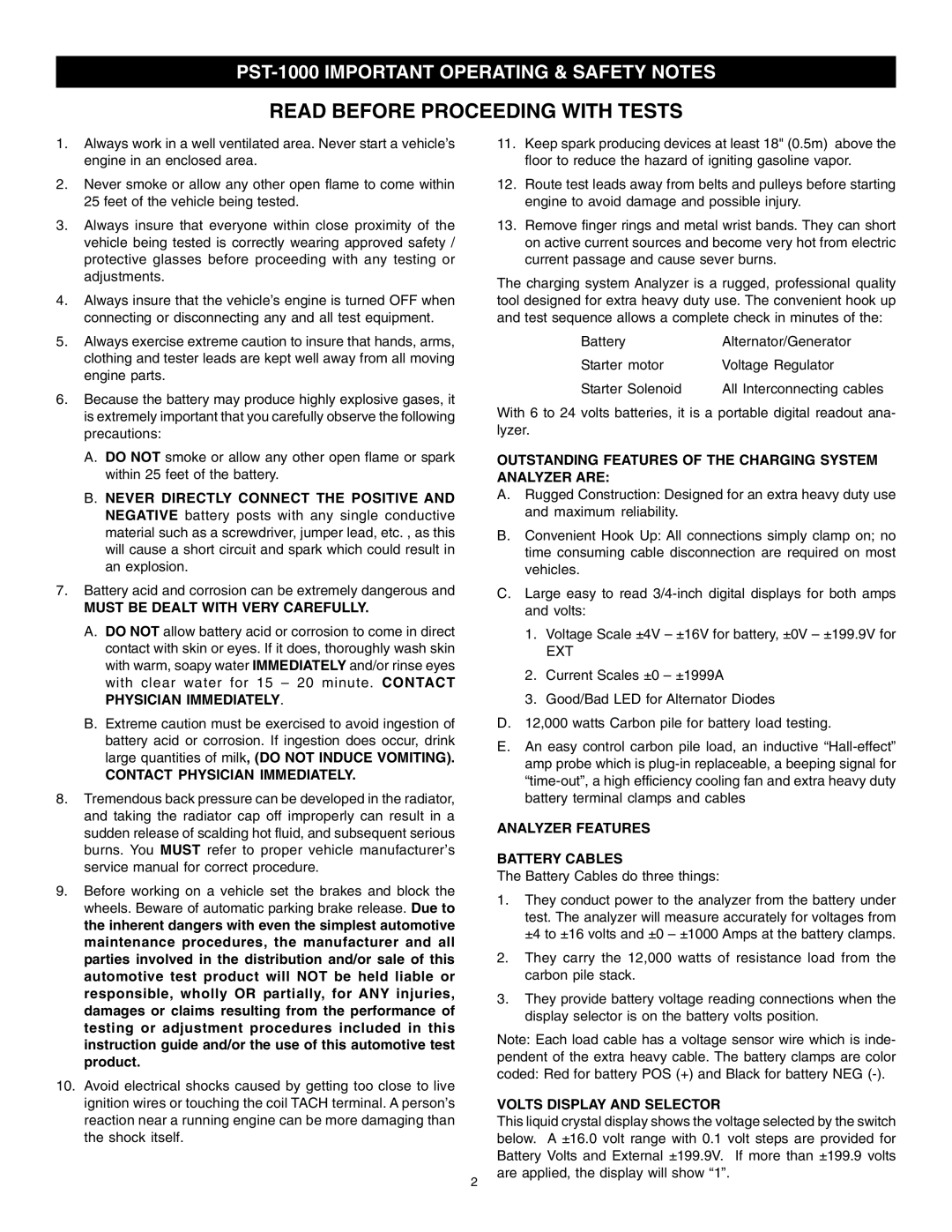READ BEFORE PROCEEDING WITH TESTS
1.Always work in a well ventilated area. Never start a vehicle’s engine in an enclosed area.
2.Never smoke or allow any other open flame to come within 25 feet of the vehicle being tested.
3.Always insure that everyone within close proximity of the vehicle being tested is correctly wearing approved safety / protective glasses before proceeding with any testing or adjustments.
4.Always insure that the vehicle’s engine is turned OFF when connecting or disconnecting any and all test equipment.
5.Always exercise extreme caution to insure that hands, arms, clothing and tester leads are kept well away from all moving engine parts.
6.Because the battery may produce highly explosive gases, it is extremely important that you carefully observe the following precautions:
A.DO NOT smoke or allow any other open flame or spark within 25 feet of the battery.
B.NEVER DIRECTLY CONNECT THE POSITIVE AND NEGATIVE battery posts with any single conductive material such as a screwdriver, jumper lead, etc. , as this will cause a short circuit and spark which could result in an explosion.
7.Battery acid and corrosion can be extremely dangerous and
MUST BE DEALT WITH VERY CAREFULLY.
A.DO NOT allow battery acid or corrosion to come in direct contact with skin or eyes. If it does, thoroughly wash skin with warm, soapy water IMMEDIATELY and/or rinse eyes with clear water for 15 – 20 minute. CONTACT PHYSICIAN IMMEDIATELY.
B.Extreme caution must be exercised to avoid ingestion of battery acid or corrosion. If ingestion does occur, drink large quantities of milk, (DO NOT INDUCE VOMITING).
CONTACT PHYSICIAN IMMEDIATELY.
8.Tremendous back pressure can be developed in the radiator, and taking the radiator cap off improperly can result in a sudden release of scalding hot fluid, and subsequent serious burns. You MUST refer to proper vehicle manufacturer’s service manual for correct procedure.
9.Before working on a vehicle set the brakes and block the wheels. Beware of automatic parking brake release. Due to the inherent dangers with even the simplest automotive maintenance procedures, the manufacturer and all parties involved in the distribution and/or sale of this automotive test product will NOT be held liable or responsible, wholly OR partially, for ANY injuries, damages or claims resulting from the performance of testing or adjustment procedures included in this instruction guide and/or the use of this automotive test product.
10.Avoid electrical shocks caused by getting too close to live ignition wires or touching the coil TACH terminal. A person’s reaction near a running engine can be more damaging than the shock itself.
2
11.Keep spark producing devices at least 18" (0.5m) above the floor to reduce the hazard of igniting gasoline vapor.
12.Route test leads away from belts and pulleys before starting engine to avoid damage and possible injury.
13.Remove finger rings and metal wrist bands. They can short on active current sources and become very hot from electric current passage and cause sever burns.
The charging system Analyzer is a rugged, professional quality tool designed for extra heavy duty use. The convenient hook up and test sequence allows a complete check in minutes of the:
Battery | Alternator/Generator |
Starter motor | Voltage Regulator |
Starter Solenoid | All Interconnecting cables |
With 6 to 24 volts batteries, it is a portable digital readout ana- lyzer.
OUTSTANDING FEATURES OF THE CHARGING SYSTEM ANALYZER ARE:
A.Rugged Construction: Designed for an extra heavy duty use and maximum reliability.
B.Convenient Hook Up: All connections simply clamp on; no time consuming cable disconnection are required on most vehicles.
C.Large easy to read
1.Voltage Scale ±4V – ±16V for battery, ±0V – ±199.9V for
EXT
2.Current Scales ±0 – ±1999A
3.Good/Bad LED for Alternator Diodes
D.12,000 watts Carbon pile for battery load testing.
E.An easy control carbon pile load, an inductive
ANALYZER FEATURES
BATTERY CABLES
The Battery Cables do three things:
1.They conduct power to the analyzer from the battery under test. The analyzer will measure accurately for voltages from ±4 to ±16 volts and ±0 – ±1000 Amps at the battery clamps.
2.They carry the 12,000 watts of resistance load from the carbon pile stack.
3.They provide battery voltage reading connections when the display selector is on the battery volts position.
Note: Each load cable has a voltage sensor wire which is inde- pendent of the extra heavy cable. The battery clamps are color coded: Red for battery POS (+) and Black for battery NEG
VOLTS DISPLAY AND SELECTOR
This liquid crystal display shows the voltage selected by the switch below. A ±16.0 volt range with 0.1 volt steps are provided for Battery Volts and External ±199.9V. If more than ±199.9 volts are applied, the display will show “1”.
